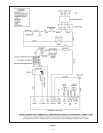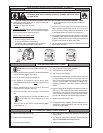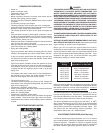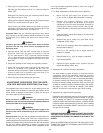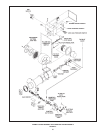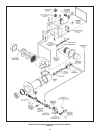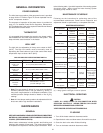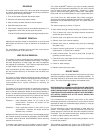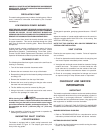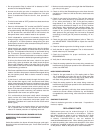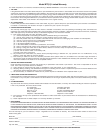
28
DRAINING
The heater must be drained if it is to be shut down and exposed
to freezing temperatures. Maintenance and service procedures
may also require draining the heater.
1. Turn off the heater electrical disconnect switch.
2. Close the cold water inlet valve to heater.
3. Open a nearby hot water faucet to vent the system.
4. Open the heater drain valve.
5. If the heater is being drained for an extended shutdown, it is
suggested the drain valve be left open this period.
• Follow FILLING instructions when restoring hot water service.
SEDIMENT REMOVAL
Waterborne impurities consist of the particles of soil and sand
which settle out and form a layer of sediment on the bottom of
the tank.
For convenience, sediment removal and lime scale removal
should be performed at the same time.
LIME SCALE REMOVAL
The amount of calcium carbonate (lime) released from water is
in direct proportion to water temperature and usage. The higher
the water temperature or water usage, the more lime deposits
are dropped out of the water. This is the lime scale which forms
in pipes, heaters and on cooking utensils.
Lime accumulation not only reduces the life of the equipment
but also reduces efficiency of the heater and increases fuel
consumption.
The usage of water softening equipment greatly reduces the
hardness of the water. However, this equipment does not always
remove all of the hardness (lime). For this reason it is
recommended that a regular schedule for deliming be
maintained.
The depth of lime build-up should be measured periodically.
Heaters will have about 3” (76 mm) of lime build-up when the
level of lime has reached the bottom of the cleanout opening or
about 1” of lime build-up if it has reached the drain valve opening.
A schedule for deliming should be set up; based on the amount
of time it would take for a 1” (25.4 mm) build-up of lime.
Example 1 – Initial inspection shows 1/2” (12.7 mm) of lime
accumulation. Therefore, the heater can be
delimed once a year.
Example 2 – Initial inspection shows 2” (50.8 mm) of lime
accumulation. Therefore, the heater should be
delimed every 3 months.
Sediment and lime scale removal may be accomplished through
the cleanout opening furnished on the heater, see FEATURES.
The heater must be drained. See DRAINING, before removing
cleanout cover on tank.
To dissolve and remove the more stubborn mineral deposits,
A.O. Smith UN•LIME
®
Professional delimer should be used.
A.O. Smith UN•LIME
®
Delimer is an easy to handle patented
food grade acid formulated specifically for lime scale removal
from all types of water using equipment. Available in 1 gallon
(part no. 4763) and 5 gallon (part no. 4813) sizes. Hydrochloric
base acids are not recommended for use on glass-lined tanks.
A.O. Smith Form No. 4800 entitled “Why, When and How”,
describes tank cleaning methods and materials. UN•LIME
®
and
the booklet may be obtained through your A.O. Smith dealer or
distributor.
The cleanout opening is shown in Figure 9.
To clean heater through cleanout opening, proceed as follows:
1. Turn off water inlet valve, the heater electrical disconnect
switch and open drain valve.
2. Remove outer cover plate from lower side of heater jacket.
3. Remove cover from cleanout opening.
4. Remove lime, scale or sediment using care not to damage
the glass lining.
5. Inspect cleanout plate gasket; if new gasket is required,
replace with A. O. Smith part no. 99038.
6. Install cleanout plate. Be sure to draw plate up tight by
tightening screws securely.
7. Close drain valve, open water inlet line and turn on the burner
electrical disconnect switch.
8. Check for water leakage.
9. Replace outer jacket cover plate.
RELIEF VALVE
At least twice a year, the temperature and pressure relief valve
should be checked to ensure that it is in operating condition. To
check the relief valve, lift the lever at the end of the valve several
times. The valve should seat properly and operate freely.
CAUTION
BEFORE MANUALLY OPERATING A RELIEF VALVE, MAKE SURE
THAT A DRAIN LINE HAS BEEN ATTACHED TO THE VALVE TO
DIRECT THE DISCHARGE TO AN OPEN DRAIN. FAILURE TO TAKE
THIS PRECAUTION COULD MEAN CONTACT WITH EXTREMELY
HOT WATER, PASSING OUT OF THE VALVE, DURING THIS
CHECKING OPERATION.
If the temperature and pressure relief valve on the heater
discharges periodically or continuously, it may be due to thermal
expansion of water in a closed water supply system, or, it may be
due to faulty relief valve.
Thermal expansion is the normal response of water when it is
heated. In a closed system, thermal expansion will cause the
system pressure to build until the relief valve actuation pressure
is equaled. Then, the relief valve will open, allowing some water
to escape, slightly lowering the pressure.
Contact your water supplier or local plumbing inspector on how
to control this situation.
Two common corrections are listed in the CHECKLIST AND
SERVICE INFORMATION that appears later in this manual.




